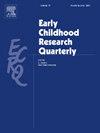Beyond repeating and growing patterns: Validating an instrument of rotating pattern understanding in preschool children
IF 3.1
1区 教育学
Q1 EDUCATION & EDUCATIONAL RESEARCH
引用次数: 0
Abstract
Research on patterning skills in preschool children has mostly focused on repeating and growing patterns. This study introduced rotating patterns as an additional pattern type and validated a self-designed instrument to assess 138 Cantonese-speaking preschool children’s (age in years: M = 4.98, SD = .33) understanding of rotating patterns based on three-wave longitudinal data. Rasch modeling was employed to evaluate the psychometric properties of the instrument. The results suggested that our instrument assessed a unidimensional construct, with items exhibiting local independence and covering a broad spectrum of easy, medium, and high difficulty levels. The instrument also possessed adequate reliability and was associated with measures of arithmetic competence and Chinese word reading, providing evidence of convergent and discriminant validity. While most items were found to be longitudinally invariant, some displayed differential functioning over time, suggesting changes in item difficulty over the assessment period. Overall, the validated instrument appears suitable for evaluating the rotating patterning skill of children aged 5 to 6 years. This study makes an important contribution by expanding the conceptualization of preschoolers’ patterning abilities to include rotating patterns, a previously underexplored domain. The psychometrically robust instrument presented in this research can also be readily utilized by scholars to further investigate the development and educational implications of children’s patterning skills.
超越重复和成长模式:验证学龄前儿童旋转模式理解的工具
对学龄前儿童模式技能的研究主要集中在重复和增长模式上。本研究引入旋转模式作为一种额外的模式类型,并验证了自行设计的基于三波纵向数据评估138名粤语学龄前儿童(年龄:M = 4.98, SD = 0.33)对旋转模式理解的工具。采用Rasch模型对仪器的心理测量特性进行评价。结果表明,我们的工具评估了一个单维结构,项目表现出局部独立性,涵盖了简单,中等和高难度水平的广泛范围。该工具还具有足够的信度,并与算术能力和中文单词阅读的测量相关联,提供了收敛效度和判别效度的证据。虽然大多数项目被发现是纵向不变的,但有些项目随着时间的推移显示出不同的功能,这表明项目难度在评估期间发生了变化。总的来说,经过验证的仪器似乎适合于评估5至6岁儿童的旋转图案技能。本研究将幼儿模式能力的概念化扩展到旋转模式,这是一个以前未被充分探索的领域。本研究中提出的心理测量稳健的工具也可以很容易地被学者们用来进一步研究儿童模式技能的发展和教育意义。
本文章由计算机程序翻译,如有差异,请以英文原文为准。
求助全文
约1分钟内获得全文
求助全文
来源期刊

Early Childhood Research Quarterly
Multiple-
CiteScore
7.00
自引率
8.10%
发文量
109
期刊介绍:
For over twenty years, Early Childhood Research Quarterly (ECRQ) has influenced the field of early childhood education and development through the publication of empirical research that meets the highest standards of scholarly and practical significance. ECRQ publishes predominantly empirical research (quantitative or qualitative methods) on issues of interest to early childhood development, theory, and educational practice (Birth through 8 years of age). The journal also occasionally publishes practitioner and/or policy perspectives, book reviews, and significant reviews of research. As an applied journal, we are interested in work that has social, policy, and educational relevance and implications and work that strengthens links between research and practice.
 求助内容:
求助内容: 应助结果提醒方式:
应助结果提醒方式:


